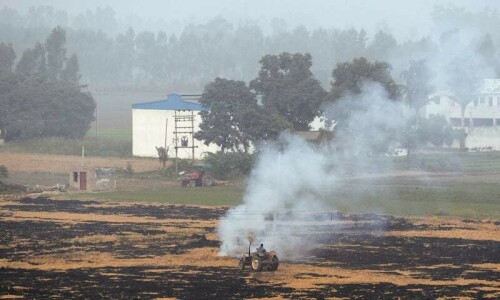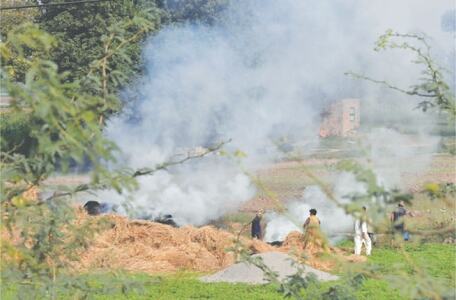There’s a continuous debate that burning rice crop residue in Punjab is the primary contributor to smog. Every year, policymakers shift all the responsibility to farmers.
In addition to policymakers, urban residents also attribute the emergence of smog to the burning of rice stubbles in Punjab. The case of Lahore is very serious as it retained its position as the world’s most polluted city for three consecutive years. This makes us believe there is a pressing need for counterfactuals to be presented from farmers’ perspectives.
Before diving into specifics, let’s review the existing evidence. Two documented pieces of evidence on smog are available to date. The first study, which analysed the entire Punjab, was conducted by the United Nations Food and Agriculture Organisation in 2018-19. This study confirms that crop residue burning contributes only 20 per cent to smog, whereas the transport sector stands as the largest contributor, accounting for 43pc of emissions, followed by industry at 25pc and the power sector at 12pc.
The second piece of evidence with a special focus on Lahore, generated by The Urban Unit in 2022, indicates that rice crop burning contributes a minor share of just 4pc to smog in the city. Meanwhile, the transport sector emerges as the primary culprit, responsible for 83pc of emissions. These findings show that the agriculture sector is not the primary contributor to smog in Punjab or Lahore.
Addressing crop residue burning is a multifaceted challenge that demands a holistic approach
Another prevailing misconception requiring rectification is that smog only occurs during winter months, especially during the last two months of the Kharif season when rice is being harvested. Historical data by IQAir reveals a consistent presence of particulate matter in the country’s atmosphere throughout the year.
So, how can farmers alone be held responsible for the presence of particulate matter in the atmosphere year-round? Air becomes a little more breathable in July and August only due to the monsoon.
Here, another question arises: why do farmers continue to burn this biomass? Apparently, they burn rice stubble due to its perceived cost-effectiveness and quick land clearance for the next crop. It’s a well-known fact that farmers face multiple issues due to price distortion in both input and output markets.
In the output market, they are forced to sell their crop even at a lower price than the government announced. At this time, when they are dealing with the output market distortions, they have to prepare land for the next crop.
At the land preparation stage, they deal with the input market issues. For instance, fertiliser prices always shoot up when they are needed the most. The practice of black marketing takes input prices at alarmingly high levels. This increases the cost of production of the next crop, while they earn less profit on the previous crop.
In this scenario, they opt for this quick and cost-effective land clearance mechanism. The social cost of this crop residue burning includes environmental and health impacts, as well as a reduction in soil nutrients for subsequent crops, which offsets the momentary benefits to the farmers.
Addressing crop residue burning is a multifaceted challenge that demands a holistic and continuous approach. Integrating technological advancements, policy reforms, financial incentives, and community engagement can alleviate this issue and enhance air quality while promoting sustainable agricultural methods.
To tackle the share of smog in the agriculture sector, providing farmers with a stable input and output market can help them make better decisions. There are some plans which are incomplete. For example, the government announced that it would provide around 5,000 machines like happy seeders at subsidised rates, but only about 500 machines have been distributed to date, resulting in minimal impact.
Financial resources allocated for constructing a single flyover in Lahore could have been directed to tackle the practice of stubble burning effectively across Punjab. Further, incorporating locally developed machines for uprooting rice crops into the incentive framework could amplify their impact.
Rice stubble shredders and happy seeders offer technical solutions by shredding stubble, incorporating it into the soil as mulch, and seeding wheat through this mulch using a seed drill. This process not only reduces the expenses of cultivating the subsequent crop but also significantly diminishes greenhouse gas emissions.
Crop residues hold potential for diverse applications, including utilisation as livestock feed or as a source for generating renewable energy. Establishing power plants or industries that utilise biomass as raw material could effectively repurpose these residues. This presents an opportunity to create various markets for crop residues, supported by subsidies or incentive structures to encourage and facilitate their utilisation in these different sectors.
To broaden the scale of efforts, public-private partnerships should be leveraged to mobilise more resources, investment and funding. However, despite their potential, administrative priorities have not reflected sufficient attention in this direction.
Establishing monitoring systems is essential to gauge the effectiveness of strategies put in place, particularly in tracking the reduction of crop residue burning, allowing for the refinement of approaches and policies using real-time data and observations.
The authors are research fellows at the Pakistan Institute of Development Economics, Islamabad
Published in Dawn, The Business and Finance Weekly, December 25th, 2023



































